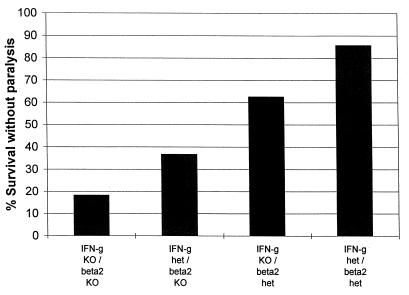FIG. 2.
Outcome of HSV infection in IFN-γKO and β2KO mice. The results show the fraction of mice surviving to day 10 (at which time surviving mice were sacrificed) without neurological impairment (paralysis or gross motor ataxia) over time in days after bilateral footpad inoculation with 5 × 105 PFU/footpad. The concentrations of virus in the footpads and spinal ganglia of the sacrificed mice are shown in Table 1, experiment 1. The numbers of mice evaluated for survival to day 10 were 11 for the IFN-γKO/β2KO mice, 8 for the IFN-γKO/β2 heterozygous (het) mice, 6 for the IFN-γ heterozygous/β2KO mice, and 7 for the IFN-γ heterozygous/β2 heterozygous mice. The overall levels of survival survival were different by log rank test (P = 0.005). Independent comparisons by Fisher’s exact test were as follows: IFN-γ heterozygous/β2 heterozygous versus IFN-γKO/β2KO mice (P = 0.01) and versus IFN-γ heterozygous/β2KO mice (P = 0.1), and IFN-γKO/β2KO versus IFN-γKO/β2 heterozygous mice (P = 0.07).

